Analysis of the Characteristics and Spatial Pattern of the Catering Industry in the Four Central Cities of the Yangtze River Delta
Abstract
:1. Introduction
2. Related Work
3. Materials and Methods
3.1. Research Area
3.2. Data Sources
3.3. Research Methods
3.3.1. Catering Industry Development Index
- Cuisine localization index (CLI)CLI represents the proportion of local cuisine among the urban cuisines, which can reflect the localization development characteristics of the urban catering industry. The formula is:where S is the total number of restaurants, Q is the total number of restaurants with local cuisines.
- Cuisine diversity index (CDI)CDI is constructed according to the Shannon–Wiener index principle in ecology [38], combined with the characteristics of urban cuisine. The CDI describes the compositional richness and balance of urban cuisine. The formula is:where S is the number of categories of cuisine, Pi is the proportion of the i-th category of cuisines. If there is only one type of cuisine in the area, the CDI reaches the minimum value of 0. When there are n types of cuisine in a specific area and are evenly distributed, the CDI reaches the maximum value .
- Cuisine geographical preference index (CGPI)CGPI [39] represents the preference index of urban residents to a specific cuisine, which can reflect the preference characteristics of the urban catering industry development. The formula is:where S is the total number of restaurants, N is the total number of restaurants of a specific cuisine.
3.3.2. Spatial Pattern of Catering Industry
- Kernel density estimationKernel density estimation is a method to study the probability of the occurrence of points at different locations in space [40]. In this study, kernel density estimation is used on the agglomeration centers and points of restaurant to obtain the spatial distribution pattern of different cuisines. The formula is:where is the kernel density function of catering industries, x is the location of restaurant points, xi is the restaurant points set to be estimated, r is the bandwidth for the search radius distance (r > 0), n is the number of restaurant points in the range of bandwidth.
- Spatial autocorrelation analysisSpatial autocorrelation analysis is used to explore the spatial agglomeration and correlation of CLI, CDI and the number of restaurants with different cuisines in different administrative districts [41]. In this study, Moran’s I index is used to analyze the global spatial correlation characteristics, and local Moran’s I index is used to analyze the spatial correlation degree between area i and surrounding areas.Moran’s I index is used to measure the spatial correlation model, which is obtained by the following formula [42]:where xi and xj are the number of restaurants in the administrative districts in the geographic units of area i and j, and wij is the spatial weight matrix. The local Moran’s I index for an area i measures the association between a value at i and values of its nearby areas, defined as [43]:where , represents the variance, and other notations are the same as in Equation (5).
3.3.3. Influencing Factors of Catering Industry
4. Results and Analysis
4.1. General Characteristics of the Development of the Catering Industry
4.2. The Characteristics of Catering Development Based on the Catering Industry Development Index
4.2.1. Regional Characteristics of Catering Based on CLI
4.2.2. Composition Characteristics of Catering Based on CDI
4.2.3. Food Preference Characteristics Based on CGPI
4.3. Catering Spatial Pattern Based on Spatial Analysis of Catering Industry
4.3.1. Spatial Distribution Pattern of Different Cuisines Based on Kernel Density Estimation
4.3.2. Spatial Agglomeration Characteristics of Different Cuisines Based on Spatial Autocorrelation Analysis
4.4. Analysis of Influencing Factors of Catering Industry Based on Geographically Weighted Regression Model
4.4.1. Regional Economic Level
4.4.2. Degree of Openness
4.4.3. Population Concentration Level
4.4.4. Market Vitality
4.4.5. Industrial Structure
5. Discussion
6. Conclusions
- (1)
- From the perspective of the overall characteristics of the catering industry, the number of Chinese restaurants is much larger than that of foreign restaurants. Shanghai and Nanjing have the highest concentration of Chinese restaurants, while Hangzhou and Hefei have formed multiple clusters. The central cities of the YRD have formed core centers of different density levels. The high-density areas of the various cities also show the characteristics of partial spatial overlap.
- (2)
- From the perspective of the catering industry development index, the local characteristics of cuisines in Hangzhou and Hefei are more prominent, and the composition of cuisines in Shanghai and Nanjing is more balanced. Shangcheng District of Hangzhou, Luyang District, and Baohe District of Hefei have the highest CLI. The CLI of all administrative districts in Shanghai and Nanjing is low. Shanghai’s Minhang District and Baoshan District have the highest CDI. The Binjiang District of Hangzhou and Baohe District of Hefei have the lowest CDI. The overall and individual catering industry in the central cities of the YRD have a significant positive correlation in space, showing a trend of convergence. The YRD prefers Sichuan cuisine and Halal Northwestern cuisine. However, Fujian cuisine, Shandong cuisine, and Yunnan and Guizhou cuisine are relatively scarce.
- (3)
- From the perspective of the catering space pattern of different cuisines, it can be divided into five types. In the first type, the main agglomeration areas are formed in the local origin area of the cuisine and other cities form weak agglomeration points. In the second type, the main agglomeration area is mainly Shanghai, supplemented by Nanjing and Hefei, and Hangzhou is the secondary agglomeration area. In the third type, Shanghai forms the main agglomeration area, Nanjing and Hefei form the secondary agglomeration areas, and Hangzhou has no obvious agglomeration point. In the fourth type, the agglomeration degree in Shanghai, Nanjing, and Hefei is not much different, but in Hangzhou is relatively weak. In the fifth type, the agglomeration degree is relatively high in the four cities, and the agglomeration range is wide and there are many agglomeration points. However, only Shanghai cuisine, Jiangsu and Zhejiang cuisine, Anhui cuisine, Fujian cuisine, Shandong cuisine, and Hunan cuisine have a significant positive correlation in space, and they weaken in turn.
- (4)
- From the perspective of the influencing factors of the catering industry, the impact strengths of the five influencing factors on CLI and CDI are roughly the same, and the order is the degree of openness, regional economic level, market vitality, population concentration level, industrial structure. The degree of openness and regional economic level are the main factors that restrict the development of CLI, and they are the main factors that inhibit and promote CDI, respectively. The geographical environment is the main factor affecting CGPI. The regional economy and population density significantly affect the cities’ high agglomeration points of catering.
Author Contributions
Funding
Informed Consent Statement
Data Availability Statement
Conflicts of Interest
References
- Yu, G.Q. Blue Book of Catering Industry: Annual Report on Catering Industry Development of China (2019); Social Sciences Academic Press of China: Beijing, China, 2019. [Google Scholar]
- Hankey, C. Food and Catering Modifications for Public Health: Chronic Disease and Obesity Prevention. Medicine 2015, 43, 135–138. [Google Scholar] [CrossRef]
- Cai, X.C.; Zhang, F.; Cheng, S.K.; Liu, X.J. Sustainable Development of the Catering Industry in China: Policy and Food Waste. J. Resour. Ecol. 2021, 12, 628–635. [Google Scholar] [CrossRef]
- Zhu, J.W.; Xu, Y.; Fang, Z.X.; Shaw, S.L.; Liu, X.J. Geographic Prevalence and Mix of Regional Cuisines in Chinese Cities. ISPRS Int. J. Geo-Inf. 2018, 7, 183. [Google Scholar] [CrossRef] [Green Version]
- Du, L. Discussion on the Characteristics of Urban Catering Culture and the Construction of “City of Food”—Taking the Two Cities of Chengdu and Chongqing as Examples. J. Chin. Cult. 2011, 3, 86–91. [Google Scholar]
- Robinson, R.N.S.; Getz, D. Profiling Potential Food Tourists: An Australian Study. Br. Food J. 2014, 116, 690–706. [Google Scholar] [CrossRef]
- Okumus, B.; Okumus, F.; McKercher, B. Incorporating Local and International Cuisines in the Marketing of Tourism Destination: The Cases of Hong Kong and Turkey. Tour. Manag. 2007, 28, 253–261. [Google Scholar] [CrossRef]
- Ribault, T. Employment in the Hotel and Catering Industry in Japan. A Comparsion with France. JIL Rep. 2002, halshs-00195594. Available online: https://halshs.archives-ouvertes.fr/halshs-00195594 (accessed on 17 March 2022).
- Zhang, Y.; Li, Q. The spatial characteristics of catering industry and its coupling analysis with dynamic population in the main city of Wuhan. J. Cent. China Norm. Univ. (Nat. Sci. Ed.) 2019, 53, 121–129. [Google Scholar] [CrossRef]
- Hou, B.; Tao, R.; Zhu, W.Z. Research on the occurrence and correlation of traditional food cultural resources in the Yangtze River Delta region. J. Res. Diet. Sci. Cult. 2014, 31, 32–38. [Google Scholar]
- Doren, C.S.V.; Gustke, L.D. Spatial analysis of the US lodging industry, 1963–1977. Ann. Tour. Res. 1982, 9, 543–563. [Google Scholar] [CrossRef]
- Wall, G.; Dudycha, D.; Hutchinson, J. Point pattern analyses of accommodation in Toronto. Ann. Tour. Res. 1985, 12, 603–618. [Google Scholar] [CrossRef]
- Thornton, L.E.; Lamb, K.E.; Ball, K. Fast food restaurant locations according to socioeconomic disadvantage, urban–regional locality, and schools within Victoria, Australia. SSM Popul. Health 2016, 2, 1–9. [Google Scholar] [CrossRef] [PubMed] [Green Version]
- Cró, S.; Martins, M.A. Hotel and hostel location in Lisbon: Looking for their determinants. Tour. Geogr. 2017, 5, 1–20. [Google Scholar] [CrossRef]
- Kim, E.J.; Geistfeld, L.V. Consumers restaurant choice behavior and the impact of socioeconomic and demographic factors. J. Food Serv. Bus. Res. 2003, 6, 3–24. [Google Scholar] [CrossRef]
- Austin, S.B.; Melly, S.J.; Sanchez, B.N.; Patel, A.; Buka, S.; Gortmaker, S.L. Clustering of Fast-Food Restaurants Around Schools: A Novel Application of Spatial Statistics to the Study of Food Environments. Am. J. Public Health 2005, 95, 1575–1581. [Google Scholar] [CrossRef]
- Ashworth, G.J.; Tunbridge, J.E. The Tourist-Historic City; Belhaven Press: London, UK, 1990. [Google Scholar] [CrossRef]
- Powell, L.M.; Chaloupka, F.J.; Bao, Y. The availability of fast-food and full-service restaurants in the United States: Associations with neighborhood characteristics. Am. J. Prev. Med. 2007, 33, 240–245. [Google Scholar] [CrossRef]
- Chou, T.Y.; Hsu, C.L.; Chen, M.C. A fuzzy multi-criteria decision model for international tourist hotels location selection. Int. J. Hosp. Manag. 2008, 27, 293–301. [Google Scholar] [CrossRef]
- Ritter, W. Hotel Location in Big Cites Tourism; Reimer: Berlin, Germany, 1986. [Google Scholar]
- Bégin, S. The geography of a tourist business hotel distribution and urban development in Xiamen, China. Tour. Geogr. 2000, 2, 448–471. [Google Scholar] [CrossRef]
- Yang, Y.; Wong, K.K.F.; Wang, T.K. How do hotels choose their location? Evidence from hotels in Beijing. Int. J. Hosp. Manag. 2012, 31, 675–685. [Google Scholar] [CrossRef]
- Prayag, G.; Landré, M.; Ryan, C. Restaurant location in Hamilton, New Zealand: Clustering patterns from 1996 to 2008. Int. J. Contemp. Hosp. Manag. 2012, 24, 430–450. [Google Scholar] [CrossRef]
- Chen, C.K. Regional differentiation and development trend of Chinese food culture. Acta Geogr. Sin. 1994, 49, 226–235. [Google Scholar]
- Lan, Y. On the Reasons and Distribution of Pungent Flavor in Chinese Food and Drink. Hum. Geogr. 2001, 16, 84–88. [Google Scholar]
- Liang, L. The distribution in space of urban catering and its factors: Xi’an as an example. J. Northwest Univ. (Nat. Sci. Ed.) 2007, 37, 925–930. [Google Scholar]
- Tang, J.Y.; He, Y.J.; Ta, N. Spatial Distribution Patterns and Factors Influencing the Shanghai Catering Industry Based on POI Data. Trop. Geogr. 2020, 40, 1015–1025. [Google Scholar] [CrossRef]
- Qin, X.; Zhen, F.; Zhu, S.J.; Xi, G.L. Spatial Pattern of Catering Industry in Nanjing Urban Area Based on the Degree of Public Praise from Internet: A Case Study of Dianping.com. Sci. Geogr. Sin. 2014, 34, 810–817. [Google Scholar] [CrossRef]
- Li, Y.Y.; Liu, H.Y.; Wang, L. Spatial Distribution Pattern of the Catering Industry in A Tourist City: Taking Lhasa City as A Case. J. Resour. Ecol. 2020, 11, 191–205. [Google Scholar] [CrossRef]
- Zeng, X.; Cui, H.S.; Liu, Z.G. Spatial and Temporal Evolution Characteristics and Influencing Factors of Restaurants in Guangzhou. Econ. Geogr. 2019, 39, 143–151. [Google Scholar] [CrossRef]
- Xu, X.Y.; Li, M. Analysis on Spatial Distribution Pattern of Beijing Restaurants based on Open Source Big Data. J. Geo-Inf. Sci. 2019, 21, 215–225. [Google Scholar]
- Zhao, W.; Cheng, Y.Y.; Zhou, L.; Yang, Y.S. Spatial Structure Characters of Special Catering Industry in the Central Area of Chengdu. Planner 2018, 34, 93–98. [Google Scholar]
- Zhou, A.H.; Zhang, Y.S.; Fu, X.; Zhu, H.Y.; Dong, H.N. Study on the spatial distribution of Beijing’s Time-honored Brand Caterings and its influencing factors. World Reg. Stud. 2015, 24, 150–158. [Google Scholar]
- Wang, Y.F.; Lin, W.S.; Feng, C.C. The Impacts of Information and Communication Technologies (ICT) on the Spatial Distribution of Urban Customer Services: A Case Study of Online Takeaway Industry in Beijing. Urban Stud. 2019, 26, 100–107. [Google Scholar]
- Shanghai Municipal Government. Shanghai Urban Master Plan (2017–2035). Available online: https://ghzyj.sh.gov.cn/ghjh/20200110/0032-811864.html (accessed on 15 December 2017).
- Kan, B.Y.; Pu, L.J.; Xu, C.Y.; Zhu, M.; Huang, S.H.; Xie, Z.D. Driving Factors on the Spatial Heterogeneity of Residential Land Pricein Downtown Nanjing Based on GWR Model. Econ. Geogr. 2019, 39, 100–107. [Google Scholar] [CrossRef]
- Liu, W. Construction of Ecological Network in the Main Urban Area of Hefei City Based on Ecological Risk Assessment. Master’s Thesis, Nanchang University, Nanchang, China, 2018. [Google Scholar]
- An, S.Q.; Wang, Z.F.; Zhu, X.L.; Hong, B.G.; Zhao, R.L. Effects of soil factors on species diversity of secondary forest communities. J. Wuhan Bot. Res. 1997, 15, 143–150. [Google Scholar]
- Gu, Q.S.; Zhang, H.P.; Zhou, X.X.; Zhao, P.F. Geographical distribution and diffusion effect of eight traditional Chinese cuisines—An empirical analysis based on the perspective of big data. Zhejiang Acad. J. 2019, 5, 47–53, 241–244. [Google Scholar] [CrossRef]
- Zuo, Y.; Chen, H.; Pan, J.; Si, Y.; Law, R.; Zhang, M. Spatial distribution pattern and influencing factors of sports tourism resources in China. ISPRS Int. J. Geo-Inf. 2021, 10, 428. [Google Scholar] [CrossRef]
- Getis, A. Spatial autocorrelation. In Handbook of Applied Spatial Analysis; Fischer, M.M., Getis, A., Eds.; Springer: Berlin, Germany, 2010. [Google Scholar] [CrossRef]
- Chen, G.; Luo, J.; Zhang, C.; Jiang, L.; Tian, L.; Chen, G. Characteristics and influencing factors of spatial differentiation of urban black and odorous waters in China. Sustainability 2018, 10, 4747. [Google Scholar] [CrossRef] [Green Version]
- Wang, F. Quantitative Methods and Socio-Economic Applications in GIS; CRC Press: Boca Raton, FL, USA, 2014. [Google Scholar] [CrossRef] [Green Version]
- Xia, L.J.; Liu, Y.F.; Liu, G.W. Distribution pattern and influencing factors of catering industry in prefecture-level cities in China: An empirical study based on the data of “Dianping.com”. Econ. Geogr. 2018, 38, 133–141. [Google Scholar] [CrossRef]
- Gao, Y.H.; Yang, Q.Q.; Liang, L.; Zhao, Y.H. Spatial pattern and influencing factors of retailing industries in Xi’an based on POI data. Sci. Geogr. Sin. 2020, 40, 710–719. [Google Scholar] [CrossRef]
- Jiang, Y.Z. The Eight Major Chinese Cuisines and the Ninth Cuisine. Essence Lit. Hist. 2013, 5, 64–68. [Google Scholar]
- Wu, L.Z.; Quan, D.J.; Zhu, H.X. Study on the Spatial Distribution of Time-honored Catering Brand and its Influencing Factors in Xi’an City. World Reg. Stud. 2017, 26, 105–114, 127. [Google Scholar]
- Zhang, X.; Xu, Y.L. Spatial distribution and influencing factors of catering facilities in Nanjing. Trop. Geogr. 2009, 29, 362–367. [Google Scholar]
- Wang, P.P.; Yan, Y. Research on the spatial pattern of catering industry in the main urban area of Xi’an based on network data. J. Ningxia Univ. (Nat. Sci. Ed.) 2019, 40, 291–296. [Google Scholar]
- Guo, J.Y. Geographical and Environmental Factors for the Formation of Eight Chinese Cuisines. Yinshan Acad. J. 2016, 30, 104–107. [Google Scholar] [CrossRef]
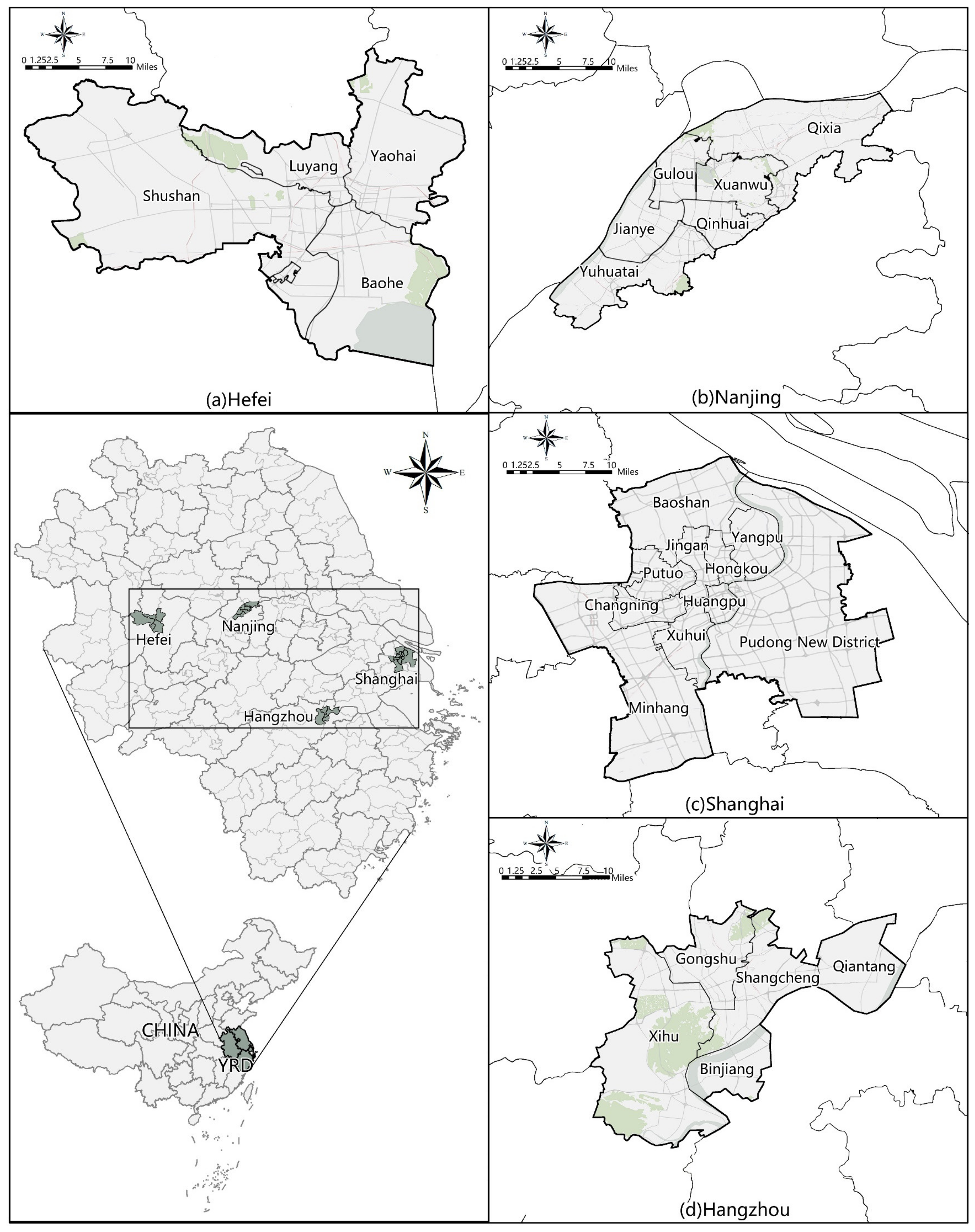

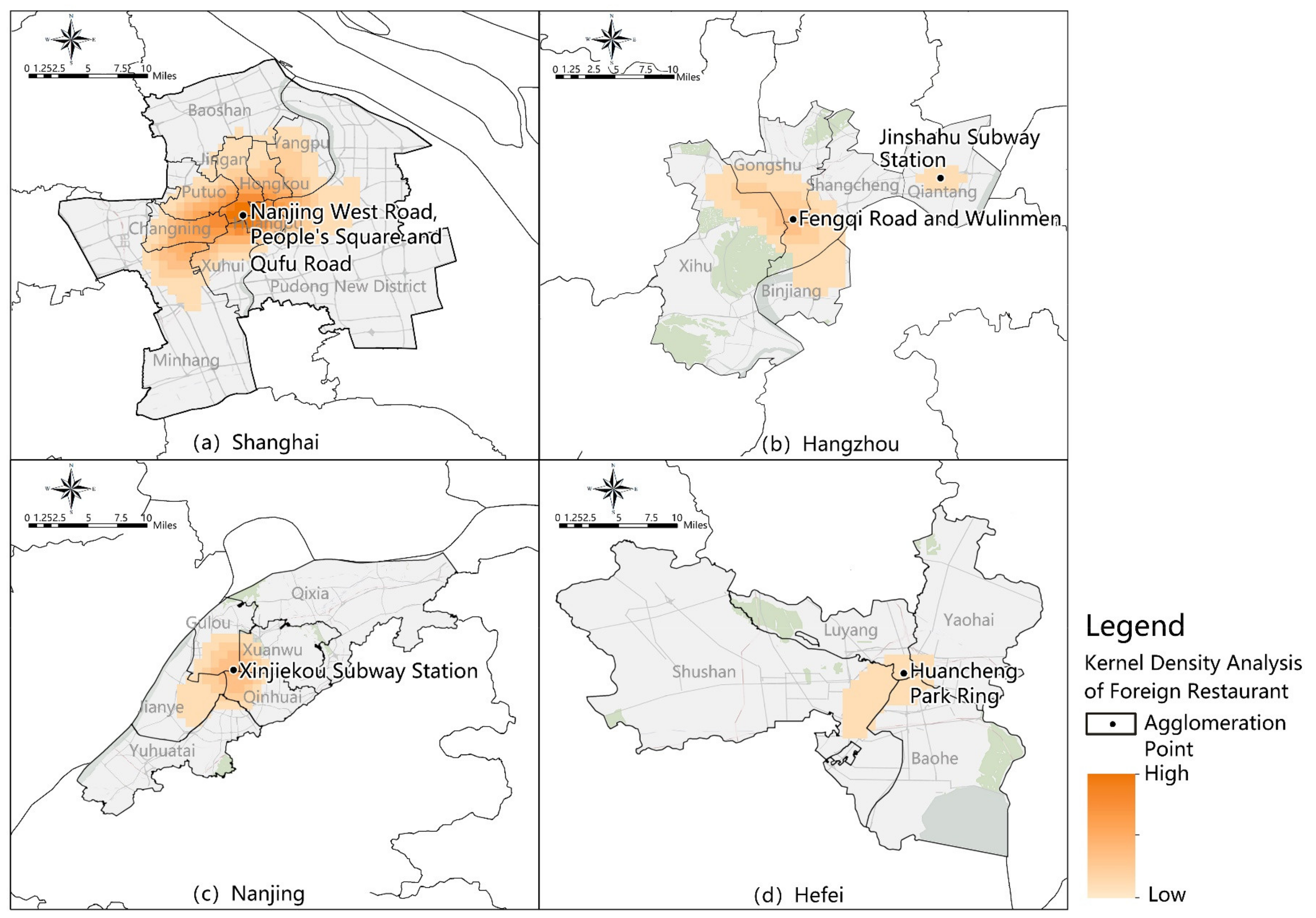
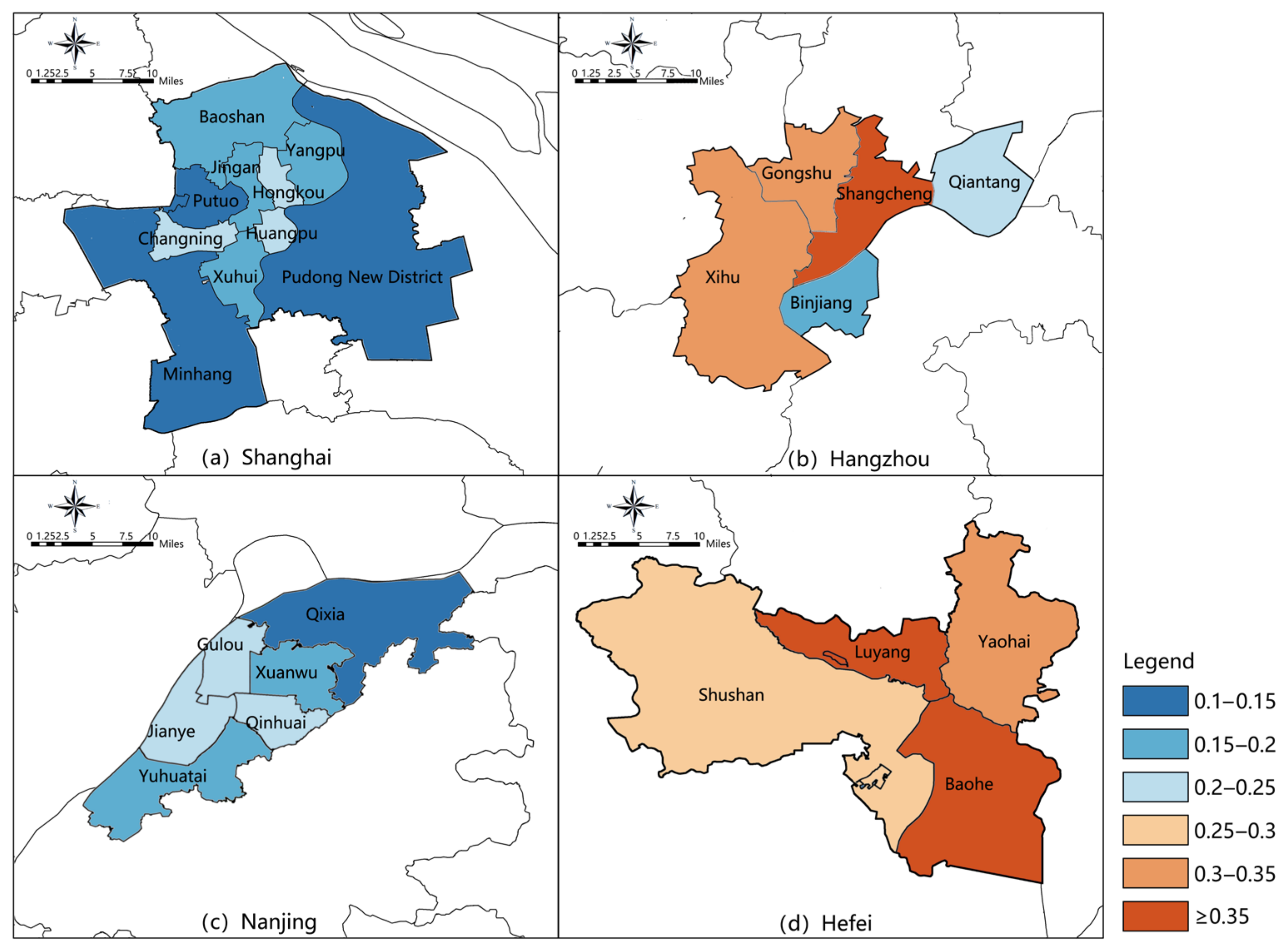

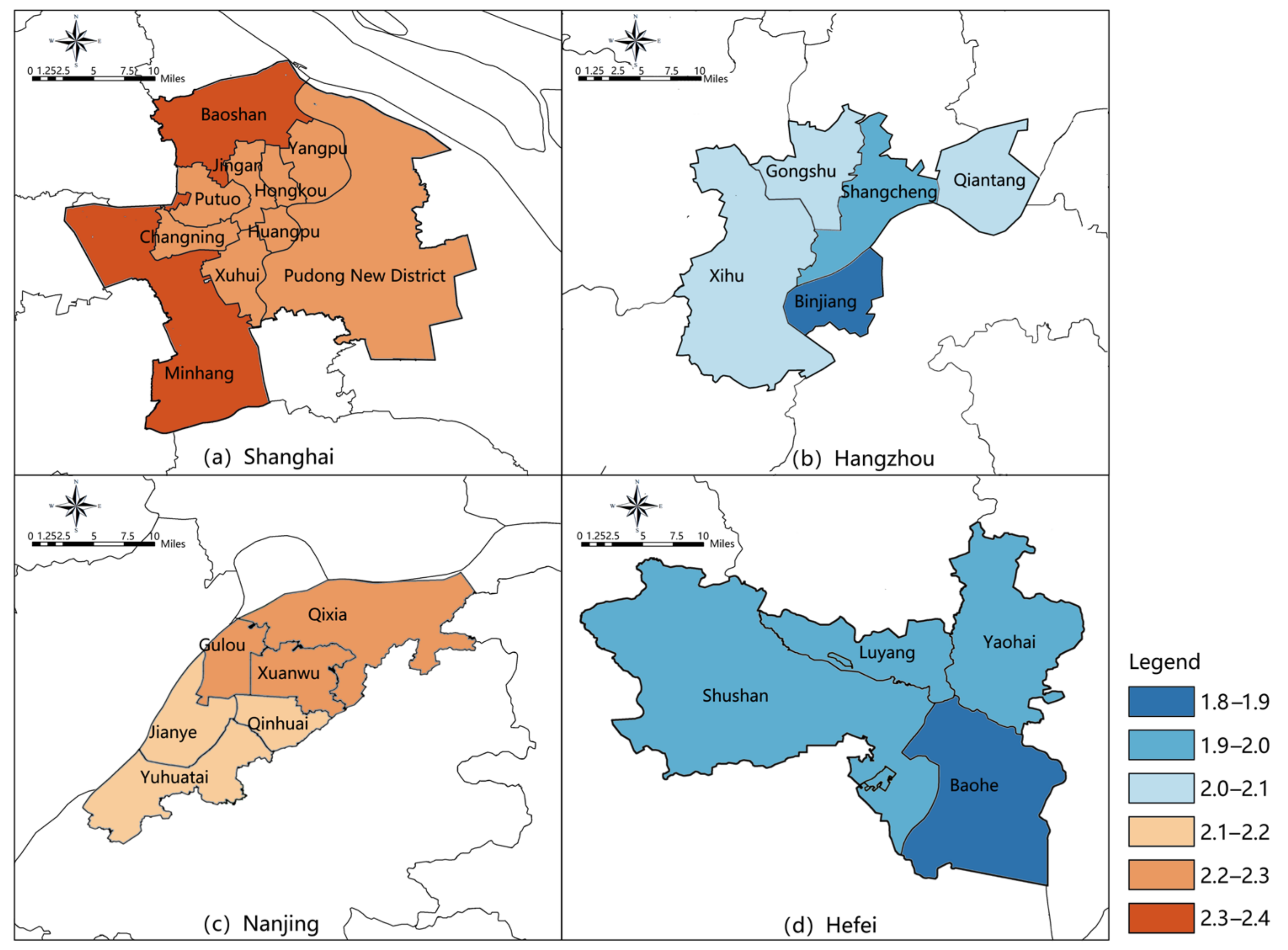
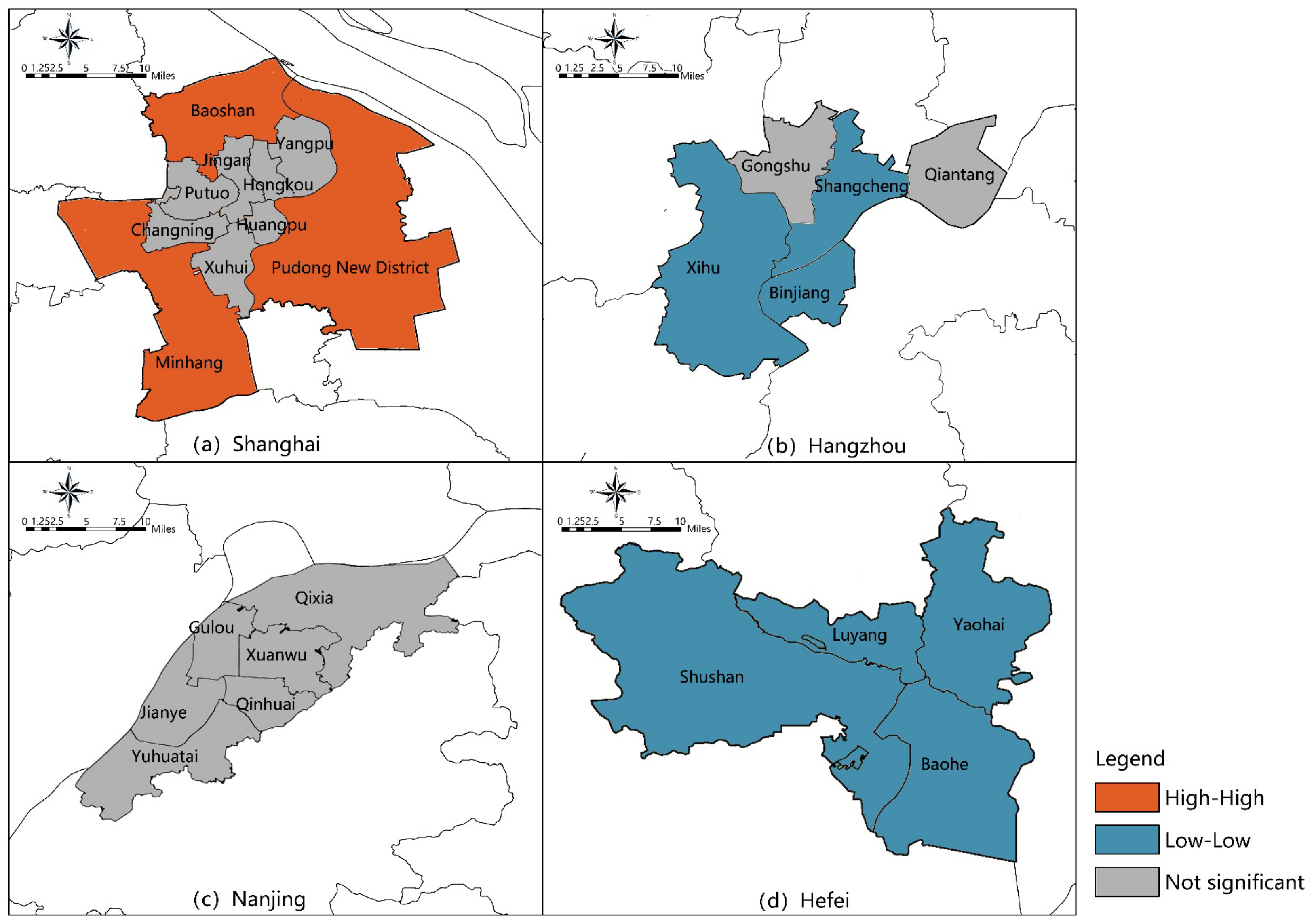
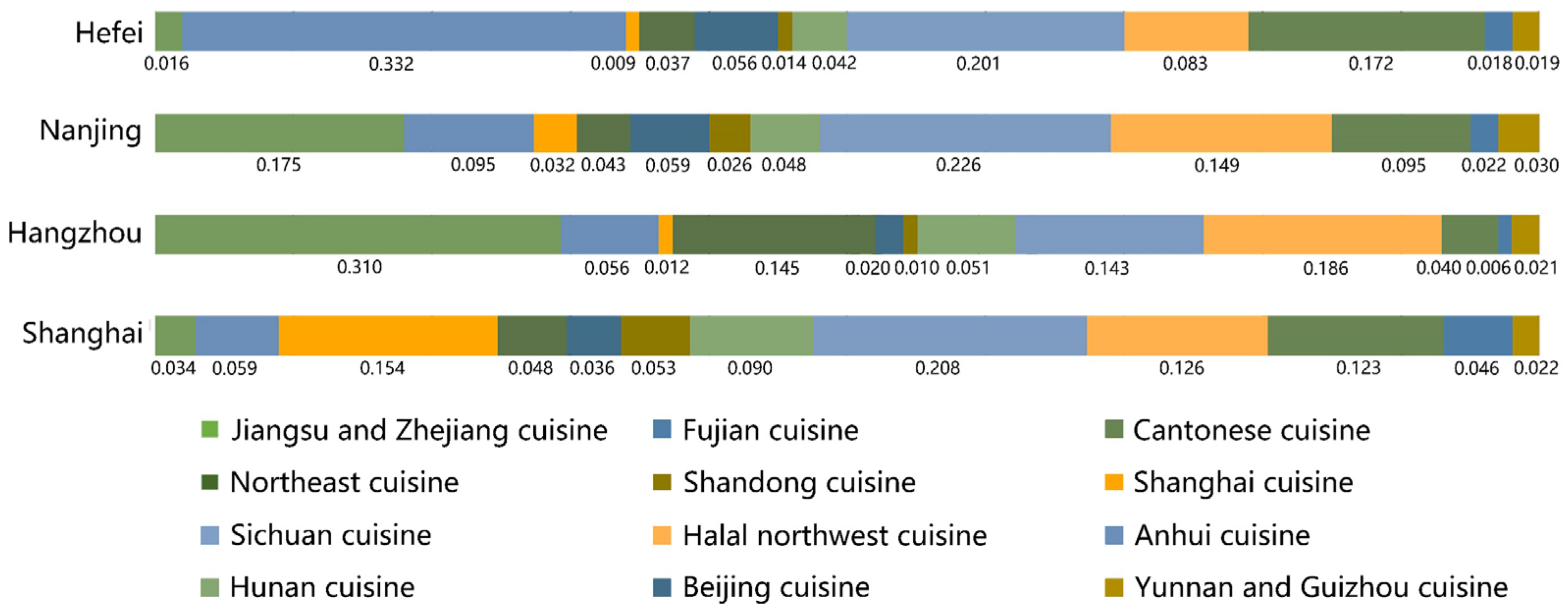

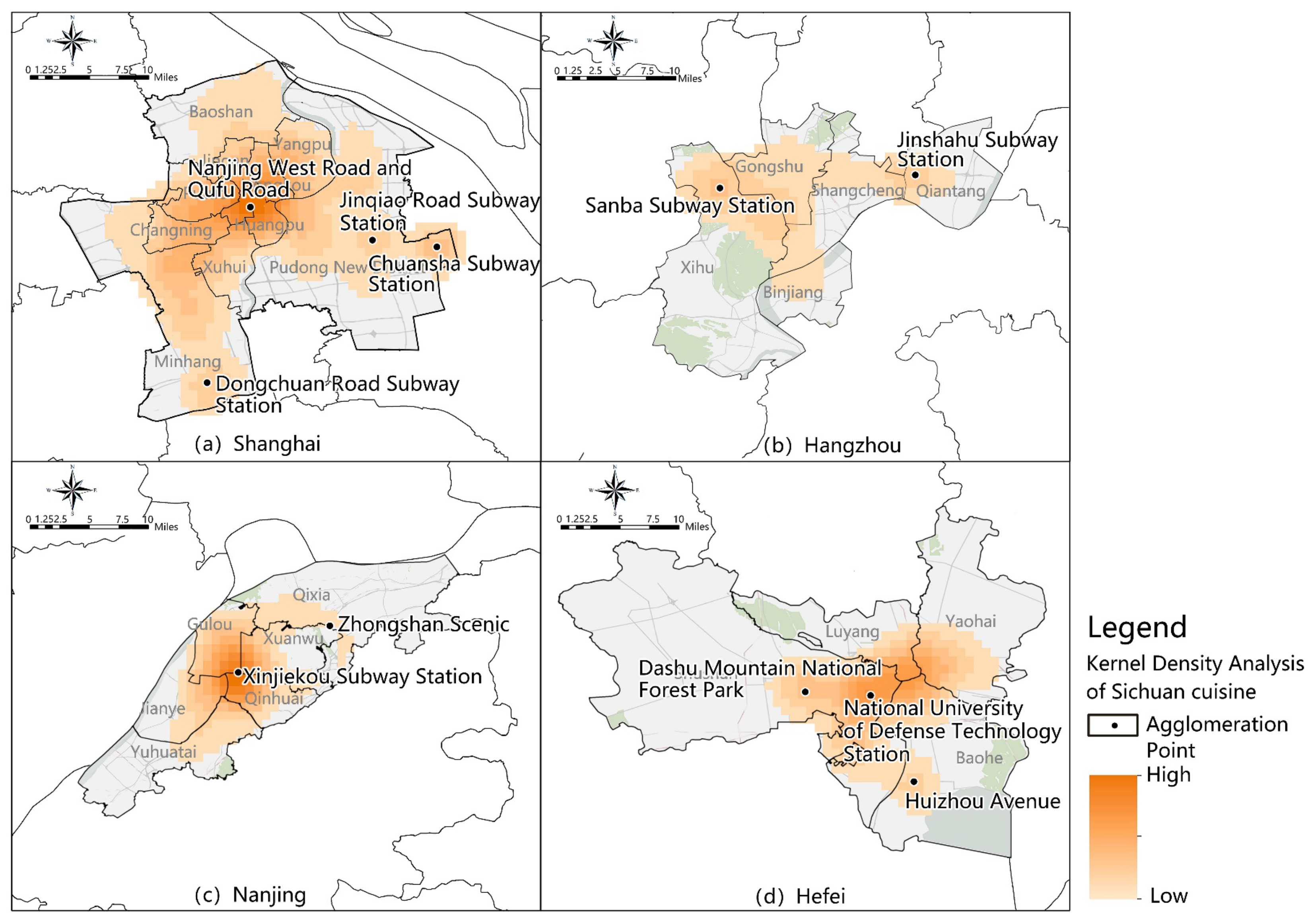


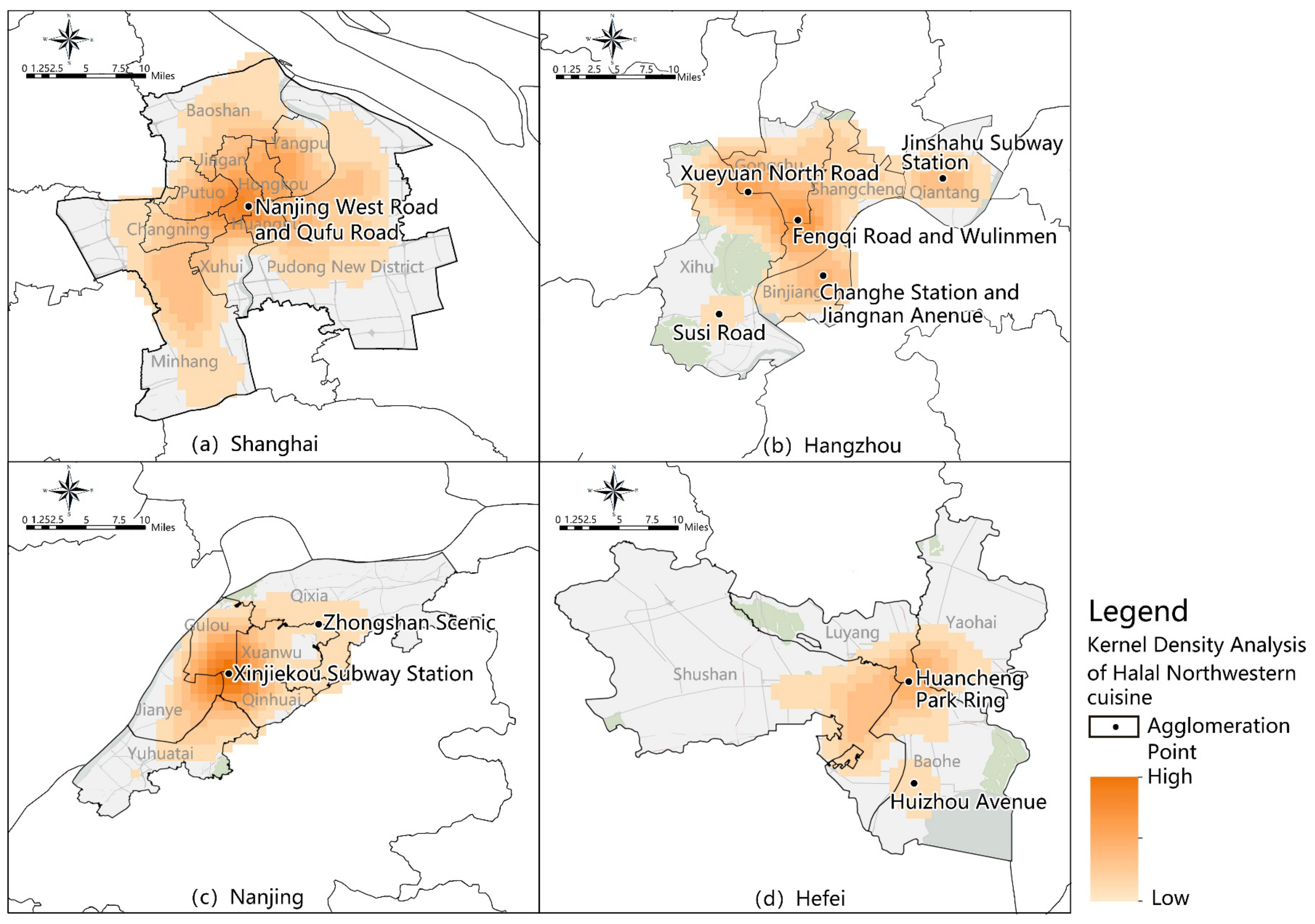
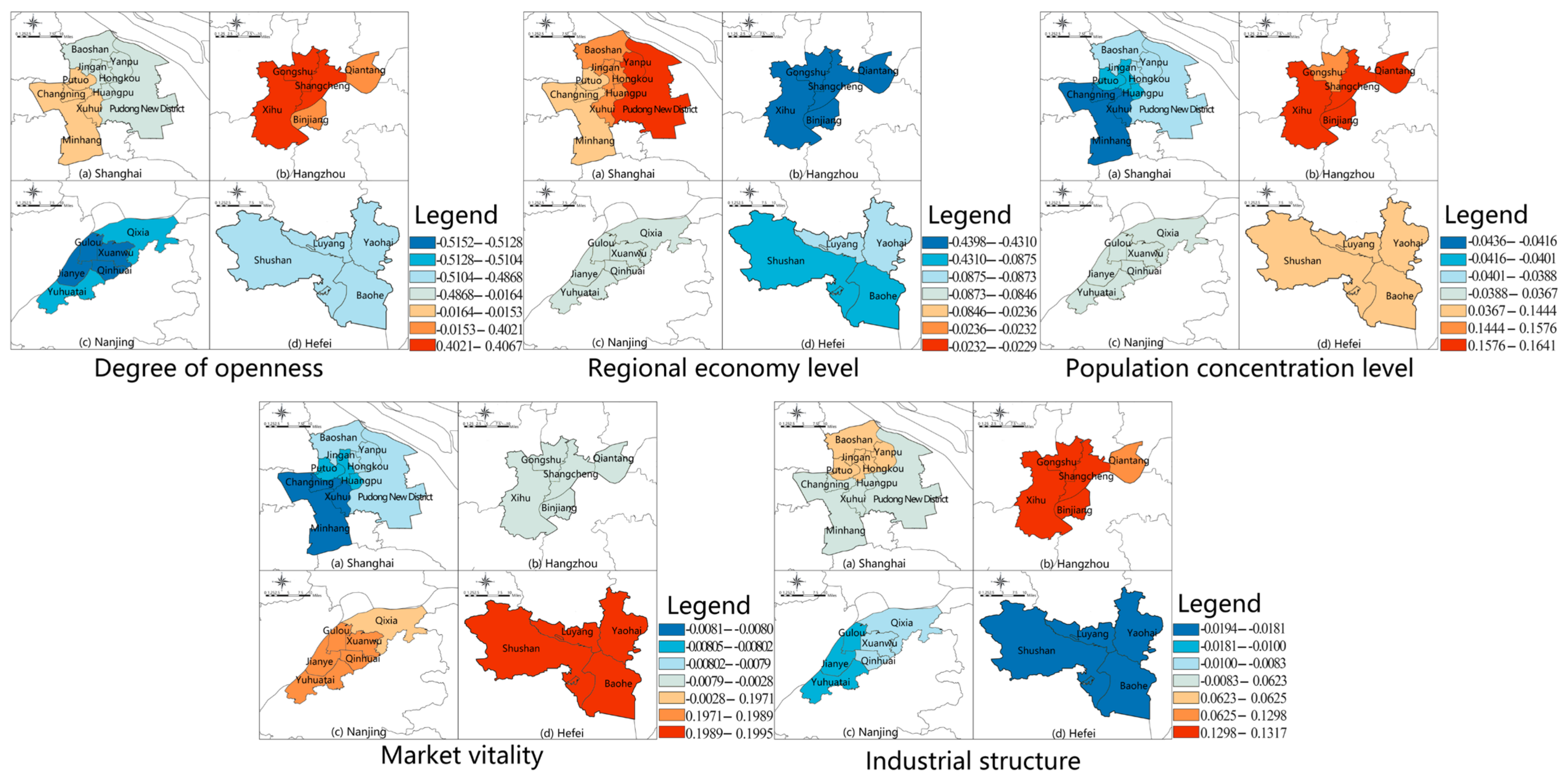

| Types and Proportions of Restaurants | Shanghai | Hangzhou | Nanjing | Hefei |
|---|---|---|---|---|
| Chinese restaurants (%) | 38.3 | 69.5 | 70.9 | 72.1 |
| foreign restaurants (%) | 3.5 | 3.7 | 3.2 | 2.1 |
| other restaurants (%) | 58.2 | 26.8 | 25.9 | 25.8 |
| Type of Cuisine | Moran’s I Index | Expectation Index | Variance | Z Score | p Value | High-High District |
|---|---|---|---|---|---|---|
| Shanghai cuisine | 0.7846 | −0.0417 | 0.0181 | 6.1418 | 0 | Minhang District, Pudong New District, Baoshan District, Huangpu District, Yangpu District, Jing’an District of Shanghai |
| Jiangsu and Zhejiang cuisine | 0.6274 | −0.0417 | 0.0173 | 5.0875 | 0 | Shangcheng District, Gongshu District and Xihu District of Hangzhou |
| Anhui cuisine | 0.5405 | −0.0417 | 0.0148 | 4.78 | 0 | Luyang District, Baohe District, Yaohai District, Shushan District of Hefei |
| Fujian cuisine | 0.5172 | −0.0417 | 0.0172 | 4.2551 | 0 | Minhang District, Pudong New District, Baoshan District of Shanghai |
| Shandong cuisine | 0.3969 | −0.0417 | 0.0153 | 3.538 | 0.0004 | Minhang District, Pudong New District, Baoshan District, Yangpu District of Shanghai |
| Hunan cuisine | 0.1842 | −0.0417 | 0.0143 | 1.8862 | 0.0592 | Minhang District, Pudong New District of Shanghai |
| Factor | Indicator | Unit |
|---|---|---|
| Regional economic level | GDP | billion |
| Per capita disposable income | yuan | |
| Population concentration level | Permanent residents | 10,000 people |
| Population density | people/km2 | |
| Industrial structure | The added value of the tertiary industry | billion |
| The proportion of the tertiary industry | % | |
| Degree of openness | Total import and export | billion |
| Market vitality | The total retail sales of social consumer goods | billion |
Publisher’s Note: MDPI stays neutral with regard to jurisdictional claims in published maps and institutional affiliations. |
© 2022 by the authors. Licensee MDPI, Basel, Switzerland. This article is an open access article distributed under the terms and conditions of the Creative Commons Attribution (CC BY) license (https://creativecommons.org/licenses/by/4.0/).
Share and Cite
Wang, W.; Wang, S.; Chen, H.; Liu, L.; Fu, T.; Yang, Y. Analysis of the Characteristics and Spatial Pattern of the Catering Industry in the Four Central Cities of the Yangtze River Delta. ISPRS Int. J. Geo-Inf. 2022, 11, 321. https://doi.org/10.3390/ijgi11060321
Wang W, Wang S, Chen H, Liu L, Fu T, Yang Y. Analysis of the Characteristics and Spatial Pattern of the Catering Industry in the Four Central Cities of the Yangtze River Delta. ISPRS International Journal of Geo-Information. 2022; 11(6):321. https://doi.org/10.3390/ijgi11060321
Chicago/Turabian StyleWang, Weiwu, Shan Wang, Huan Chen, Lingjun Liu, Tianle Fu, and Yuxin Yang. 2022. "Analysis of the Characteristics and Spatial Pattern of the Catering Industry in the Four Central Cities of the Yangtze River Delta" ISPRS International Journal of Geo-Information 11, no. 6: 321. https://doi.org/10.3390/ijgi11060321






